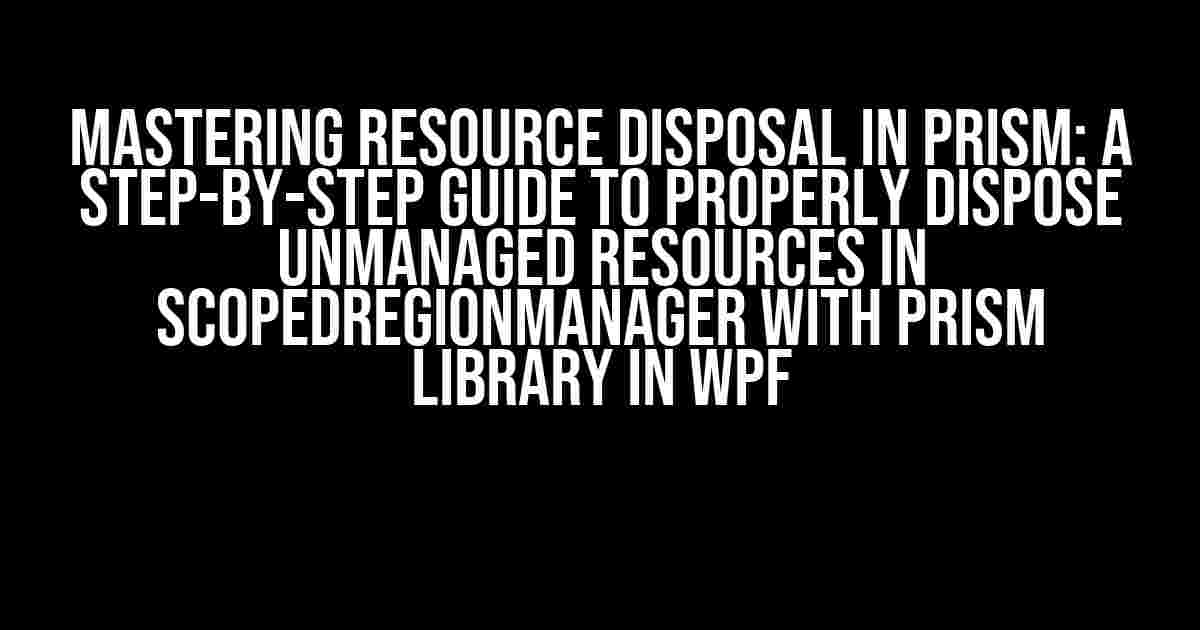Are you tired of dealing with pesky memory leaks and resource conflicts in your WPF application using Prism? Do you struggle to properly dispose of unmanaged resources in your ScopedRegionManager? Well, worry no more! In this comprehensive guide, we’ll take you by the hand and walk you through the process of correctly disposing of unmanaged resources in Prism, ensuring a stable and efficient application.
Understanding the Importance of Resource Disposal
In WPF, resources such as database connections, file streams, and graphics devices are essential for your application’s functionality. However, these resources can lead to memory leaks, crashes, and performance issues if not properly disposed of. Unmanaged resources, in particular, require special attention, as they’re not automatically garbage collected by the .NET runtime.
ScopedRegionManager, a key component of the Prism library, provides a convenient way to manage regions and their associated views. However, it’s crucial to understand how to properly dispose of unmanaged resources within this context to avoid common pitfalls.
Why You Need to Dispose of Unmanaged Resources in ScopedRegionManager
There are several compelling reasons to dispose of unmanaged resources in ScopedRegionManager:
- Memory Leaks Prevention**: Unmanaged resources can lead to memory leaks, causing your application to consume increasing amounts of memory over time.
- Resource ContentionResolution**: Disposing of unmanaged resources helps resolve resource contention issues, ensuring that multiple components don’t conflict over the same resource.
- Improved Performance**: Proper resource disposal can significantly improve your application’s performance, as unnecessary resources are released back to the system.
How to Dispose of Unmanaged Resources in ScopedRegionManager
Now that we’ve covered the importance and benefits of disposing of unmanaged resources, let’s dive into the step-by-step process of doing so:
Step 1: Implement IDisposable on Your View Model
Start by implementing the IDisposable interface on your view model class:
public class MyViewModel : IDisposable
{
// View model implementation
public void Dispose()
{
// Dispose of unmanaged resources here
}
}Step 2: Register Your View Model with the Container
Register your view model with the container, ensuring it’s properly instantiated and managed by Prism:
container.RegisterType<MyViewModel>();Step 3: Create a Region Adapter for Your View
Create a region adapter for your view, which will handle the disposal of unmanaged resources:
public class MyRegionAdapter : RegionAdapterBase<MyView>
{
protected override void AdaptRegionNavigationService(IRegion region, IRegionNavigationService navigationService)
{
base.AdaptRegionNavigationService(region, navigationService);
navigationService.Region.Deactivate -= OnRegionDeactivate;
navigationService.Region.Deactivate += OnRegionDeactivate;
}
private void OnRegionDeactivate(object sender, DeactivationEventArgs e)
{
if (e.Item is MyView view)
{
if (view.DataContext is IDisposable disposable)
{
disposable.Dispose();
}
}
}
}Step 4: Register the Region Adapter with the Region
Register the region adapter with the region, ensuring it’s used to manage the view:
regionAdapterMappings.RegisterMapping(typeof(MyView), container.Resolve<MyRegionAdapter>());Step 5: Dispose of Unmanaged Resources in the View Model
Finally, implement the Dispose method in your view model to release unmanaged resources:
public void Dispose()
{
// Dispose of unmanaged resources here, such as:
_databaseConnection?.Dispose();
_fileStream?.Dispose();
}Best Practices for Resource Disposal in ScopedRegionManager
To ensure effective resource disposal in ScopedRegionManager, follow these best practices:
- Implement IDisposable on All View Models**: Ensure all view models implement the
IDisposableinterface to provide a uniform way of disposing of unmanaged resources. - Use the Region Adapter to Manage Views**: Leverage region adapters to manage views and dispose of unmanaged resources when the view is deactivated.
- Dispose of Resources in the View Model**: Implement the
Disposemethod in your view model to release unmanaged resources, ensuring they’re properly disposed of. - Avoid Disposing of Resources in Finalizers**: Instead of relying on finalizers, which can lead to performance issues, use the
Disposemethod to explicitly release unmanaged resources.
| Resource Type | Disposal Method |
|---|---|
| Database Connection | Close() or Dispose() |
| File Stream | Close() or Dispose() |
| Graphics Device | Dispose() |
Conclusion
Properly disposing of unmanaged resources in ScopedRegionManager with Prism Library in WPF is crucial for maintaining a stable and efficient application. By following the steps and best practices outlined in this article, you’ll be well on your way to ensuring resource disposal is handled correctly, avoiding common pitfalls and performance issues.
Remember to implement IDisposable on your view models, register region adapters, and dispose of unmanaged resources in the view model. With these practices in place, you’ll be able to confidently build robust and scalable WPF applications using Prism.
Happy coding!
Here are 5 Questions and Answers about “How to Properly Dispose Unmanaged Resources in ScopedRegionManager with Prism Library in WPF”:
Frequently Asked Question
Unlock the secrets to proper resource disposal in Prism’s ScopedRegionManager!
Why do I need to dispose unmanaged resources in ScopedRegionManager?
Disposing unmanaged resources is crucial to prevent memory leaks and ensure your WPF application remains stable. Prism’s ScopedRegionManager provides a way to manage regions, but it’s up to you to properly dispose of unmanaged resources, such as database connections, file handles, or COM objects.
How do I identify unmanaged resources in my ScopedRegionManager?
Take a closer look at your region’s view models and views. Any objects that implement IDisposable, such as database connections or file streams, are likely unmanaged resources. You may also have COM objects, like Excel interop objects, that require explicit disposal.
Can I use Prism’s built-in dispose mechanism to clean up unmanaged resources?
Prism provides a way to dispose of view models and views through the IRegionMembershipLifetime interface. However, this mechanism only disposes of managed resources, not unmanaged ones. You’ll need to implement your own disposal logic for unmanaged resources.
How do I properly dispose of unmanaged resources in ScopedRegionManager?
Create a custom implementation of IRegionBehavior and override the RemoveFromRegion method. In this method, iterate through the region’s views and view models, and explicitly dispose of any unmanaged resources. Don’t forget to call the base implementation to ensure Prism’s managed resources are disposed of as well.
Are there any best practices for disposing unmanaged resources in ScopedRegionManager?
Yes! Always follow the Dispose Pattern, which ensures that unmanaged resources are released even when an exception occurs. Additionally, consider using a using statement or a try-finally block to guarantee disposal. And, of course, test your implementation thoroughly to ensure resources are properly released.
I hope this helps!


